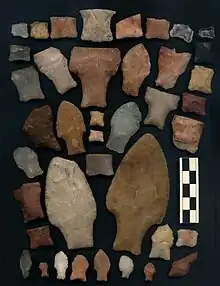Fishtail projectile point
Fishtail points, also known as Fell points are a style of Paleoindian projectile point widespread in South America at the end of the Late Pleistocene.[1] Their chronological timing is disputed, with some authors favouring a short chronology spanning 12,800–12,200 years Before Present (BP), while others favouring a long chronology spanning 13,500–10,200 years BP.[2] It is the earliest widespread lithic style in South America,[3] being contemporaneous in its earlier stages to the use of Clovis points in North America.[1] Fishtail points may be derived from Clovis points,[4][5] or possibly from Fishtail-like points found on the Gulf Coast of North America and in Central America.[6]

The name "Fishtail point" derives from their fish-like shape, with broad shoulders, indented stems and flared bases, while the name "Fell point" originally given by Junius Bird derives from Cueva Fell (Fell's Cave) in southern Patagonia, where the first points were found.[7] They are typically bifacially thinned, though some unifacial Fishtail points are known.[8] In comparison to Clovis points, Fishtail points are often but not always fluted (having a long flake running along the length of the point removed, leaving a groove at the base).[9][1] Fishtail points varied significantly in size and form, and many were likely hafted to spears,[2][5] which were possibly used in combination with spear throwers,[3] though some may have served other purposes, like as knives, and the same point may have been used for multiple functions.[5]
Fishtail points have the highest find frequency in the open regions of the Pampas and Patagonia, but are also found with some frequency in the Andes, extending as far north as Ecuador.[1] While Brazilian finds are most common in Southern Brazil, some finds are also known from central, northern and northeastern Brazil, including in the states of Mato Grosso, Goiás, Amazonas and Bahia.[10]
The points are suggested to have been primarily utilized for big-game hunting of megafaunal mammals[3] and the peak abundance of the points coincides with the proposed extinction interval for most large mammals in South America as part of the Quaternary extinction event, suggesting that the hunting may have had a causal role in the extinctions. Fishtail points disappeared following the extinction of the megafauna, and were replaced by projectile point styles better suited for hunting smaller prey.[1]
Direct association between Fishtail points and extinct megafauna are rare,[3] though extinct megafauna known to be directly associated with Fishtail points include the equine Hippidion saldiasi and llama Lama gracilis (which appears to be closely related/possibly synonymous with the living vicuña[11]), as well as with the living guanaco.[12][13]
References
- Prates, Luciano; Perez, S. Ivan (2021-04-12). "Late Pleistocene South American megafaunal extinctions associated with rise of Fishtail points and human population". Nature Communications. 12 (1): 2175. Bibcode:2021NatCo..12.2175P. doi:10.1038/s41467-021-22506-4. ISSN 2041-1723. PMC 8041891. PMID 33846353.
- Hermo, Darío; Miotti, Laura; Terranova, Enrique (2022-01-02). "Exploring Technological Choices in Fishtail Points from Southern Contexts: A Comparative Overview". PaleoAmerica. 8 (1): 79–94. doi:10.1080/20555563.2021.2000090. ISSN 2055-5563. S2CID 246217494.
- Prates, Luciano; Rivero, Diego; Perez, S. Ivan (2022-10-25). "Changes in projectile design and size of prey reveal the central role of Fishtail points in megafauna hunting in South America". Scientific Reports. 12 (1): 16964. Bibcode:2022NatSR..1216964P. doi:10.1038/s41598-022-21287-0. ISSN 2045-2322. PMC 9596454. PMID 36284118.
- Fiedel, Stuart J. (July 2017). "The Anzick genome proves Clovis is first, after all". Quaternary International. 444: 4–9. Bibcode:2017QuInt.444....4F. doi:10.1016/j.quaint.2017.06.022.
- Suárez, Rafael; Cardillo, Marcelo (October 2019). "Life history or stylistic variation? A geometric morphometric method for evaluation of Fishtail point variability". Journal of Archaeological Science: Reports. 27: 101997. Bibcode:2019JArSR..27j1997S. doi:10.1016/j.jasrep.2019.101997. ISSN 2352-409X. S2CID 202898399.
- Nami, Hugo G. (2021). "Fishtailed projectile points in the Americas: Remarks and hypotheses on the peopling of northern South America and beyond". Quaternary International. 578: 47–72. Bibcode:2021QuInt.578...47N. doi:10.1016/j.quaint.2020.06.004. ISSN 1040-6182. S2CID 225430302.
- Waters, Michael R.; Amorosi, Thomas; Stafford, Thomas W. (April 2015). "Redating Fell's Cave, Chile and the Chronological Placement of the Fishtail Projectile Point". American Antiquity. 80 (2): 376–386. doi:10.7183/0002-7316.80.2.376. ISSN 0002-7316. S2CID 163247912.
- Suarez, Rafael. 2009. Unifacial Fishtail Points: Considerations about the archaeological record of Paleo South Americans. Current Research in the Pleistocene 26:12–15.
- Morrow, Juliet E.; Morrow, Toby A. (April 1999). "Geographic Variation in Fluted Projectile Points: A Hemispheric Perspective". American Antiquity. 64 (2): 215–230. doi:10.2307/2694275. ISSN 0002-7316. JSTOR 2694275. S2CID 131210143.
- Loponte, Daniel; Okumura, Mercedes; Carbonera, Mirian (2015-03-15). "New records of fishtail projectile points from Brazil and its implications for its peopling". Journal of Lithic Studies. 3 (1). doi:10.2218/jls.v3i1.1312. ISSN 2055-0472.
- Moscardi, Bruno; Rindel, Diego D.; Perez, S. Ivan (March 2020). "Human diet evolution in Patagonia was driven by the expansion of Lama guanicoe after megafaunal extinctions". Journal of Archaeological Science. 115: 105098. doi:10.1016/j.jas.2020.105098.
- Nami, Hugo G. (2019-08-12). "Paleoamerican Occupation, Stone Tools from the Cueva del Medio, and Considerations for the Late Pleistocene Archaeology in Southern South America". Quaternary. 2 (3): 28. doi:10.3390/quat2030028. ISSN 2571-550X.
- Bampi, Hugo; Barberi, Maira; Lima-Ribeiro, Matheus S. (December 2022). "Megafauna kill sites in South America: A critical review". Quaternary Science Reviews. 298: 107851. doi:10.1016/j.quascirev.2022.107851.